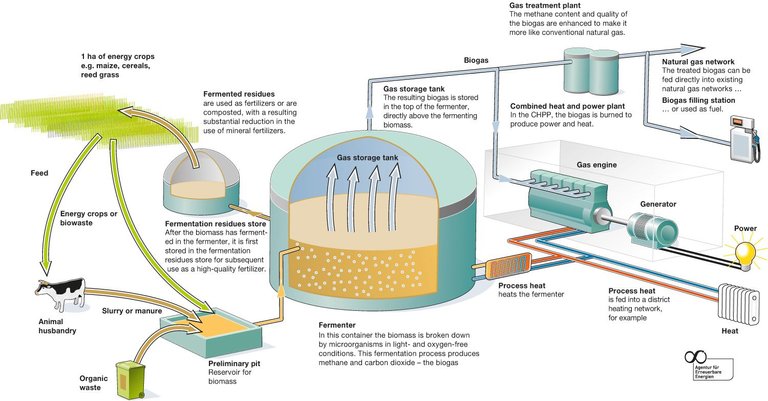OPTIMAL RATIO OF COW MANURE TO VEGETABLE WASTE IN THE PRODUCTION OF BIO-FLAME
Greetings, dear readers! It is a great pleasure to embark on another journey of knowledge to share with you about biogas as different environmental and economic concerns arise with the problems related to the availability of cooking fuel. In the previous article, we have already shared a brief overview about our research and its main purpose or goals. Now, in this article, let us expand our knowledge by unfolding different existing studies and literature that serves as our foundation in the creation of our research and/or unlocking different concepts related to biogas.
WHAT IS BIOGAS?
Biogas, as defined by Obaideen et al. (2022), is a promising renewable energy source that has more advantages than “natural gas''. This eco-friendly fuel goes to a process called anaerobic digestion which is produced after an organic material (animal manure, plants) is digested or broken down by a bacterium in an oxygen free environment.
Reference: Obaideen, K., Abdelkareem, M.A., Willberforce T., Elsaid, K., Sayed E.T., Maghrabie, H.M., & Olabi A.G. (2022). “Biogas Role in Achievement of the Sustainable Development Goals: Evaluation, Challenges and Guidelines”., Journal of the Taiwan Institute of Chemical Engineers, vol.131. https://doi.org/10.1016/j.jtice.2022.104207
BENEFITS OF BIOGAS
As indicated in the study by Femi et al. (2018), biogas produced by anaerobic digestion of wastewater, organic waste, agricultural waste, industrial waste, and animal by-products is a potential source of renewable energy. It can be used as an alternative for the traditional natural gas to generate combined electricity and heating for power plants with the right process which could be anaerobic digestion or through thermo chemicals. Similarly, it can be an alternative solution to reduce waste and can be converted as a new renewable resource. This can be used in cooking and to eliminate such waste like animal manure and vegetable waste. Besides having an alternative fuel gas, biogas production can also help in our economy.
Femi, T., Ahmed, I., Helen, O. and Satyavolu, J. (2018) Production of Ethanol from Cassava Peelings Using a Developed Percolation Reactor. Journal of Sustainable Bioenergy Systems, 8, 107-115. https://doi.org/10.4236/jsbs.2018.84008
In the context of Filipino households, liquefied petroleum gas (LPG) stands as a cornerstone fuel for domestic cooking, heating, and lighting. However, the fluctuation of LPG prices pose a significant challenge to household budgets, prompting a search for more cost-effective alternatives. Tecson (2022) proposes biogas as a viable solution to mitigate these challenges.By leveraging biogas as a substitute for LPG, households can reduce their dependence on costly fossil fuels while simultaneously addressing ecological waste management issues. This transition not only alleviates financial burdens but also fosters a cleaner, waste-free environment by repurposing organic waste materials. In essence, biogas emerges not only as a practical energy source but also as a catalyst for sustainable development and environmental stewardship.
Tecson, Z. (2022). “DOST-funded digester to convert wastes to biogas in Aurora”. The Philippine News Agency. https://www.pna.gov.ph/articles/1180413
In recent years, biogas production, as a sustainable alternative to traditional fossil fuels, gained significant attention due to its potential to mitigate environmental concerns and reduce dependency on limited resources. With this, researchers have long sought the perfect combination of ingredients to unlock the full potential of biogas production . Among these ingredients are cow manure and vegetable waste that we also used in our research considering the availability of these materials around our area.
Previous research, like that of Pakvilai (2021), explored different combinations of cow dung and food waste in small-scale ratios, ranging from 75:25 to 100:0 ratios. Whereas, the 75:25 ratio emerged as the one with higher yield of biogas compared to other compositions, showcasing the significant impact of substrate ratios on biogas yield.
Pakvilai, N. (2021). “The Potential of Biogas Production with Co-Digestion between food waste and cow dung”. https://doi.org/10.48048/tis.2021.1410
Similarly, Makhura et al. (2020) examined the co-digestion of food waste and cow dung, investigating ratios ranging from 1:1 to 1:3 which revealed that biogas yield increased when cow dung was mixed with food waste. Among the tested ratios, a 1:2 mixture of cow dung to food waste demonstrated the highest accumulated gas volume, highlighting the synergistic effect of co-digestion on biogas production.
Makhura, E. P., Muzande, E., & Lekgoba, T. (2020). “Effect of co-digestion of food waste and cow dung on biogas yield”. https://doi.org/10.1051/e3sconf/202018101005
In conclusion, the journey into the realm of biogas unveils a myriad of opportunities for both environmental conservation and economic empowerment. As we continue to explore its potential, let us remain steadfast in our commitment to harnessing nature's bounty for the betterment of society and the planet as a whole. Together, let us embark on this journey towards a brighter and more sustainable future fueled by the power of biogas.
RESEARCHERS:
Group Leader: Cheska Maramot (@chskmrmt)
Writer: Ericha Joy M. Urgel (@joyrgl)
Co-Researchers:
Reinald B. Compas (@ynadbonquin)
John Edrian D. De Chavez (@)
Ayessa Jane A. Dolor (@ayeaye222)
Virgielly S. Luyong (@gielly)
Alexalouise B. Reyes
Daniela E. Siazon (@nyela)
Ken Lourence J. Tecson (@kentecson000021)
